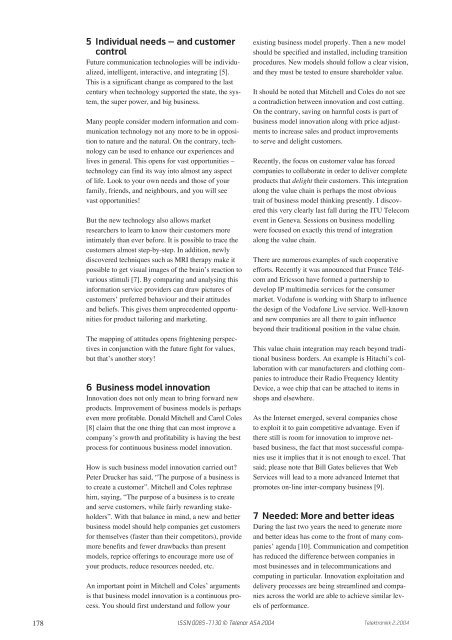Innovation Practice - Telenor
Innovation Practice - Telenor
Innovation Practice - Telenor
Create successful ePaper yourself
Turn your PDF publications into a flip-book with our unique Google optimized e-Paper software.
178<br />
5 Individual needs – and customer<br />
control<br />
Future communication technologies will be individualized,<br />
intelligent, interactive, and integrating [5].<br />
This is a significant change as compared to the last<br />
century when technology supported the state, the system,<br />
the super power, and big business.<br />
Many people consider modern information and communication<br />
technology not any more to be in opposition<br />
to nature and the natural. On the contrary, technology<br />
can be used to enhance our experiences and<br />
lives in general. This opens for vast opportunities –<br />
technology can find its way into almost any aspect<br />
of life. Look to your own needs and those of your<br />
family, friends, and neighbours, and you will see<br />
vast opportunities!<br />
But the new technology also allows market<br />
researchers to learn to know their customers more<br />
intimately than ever before. It is possible to trace the<br />
customers almost step-by-step. In addition, newly<br />
discovered techniques such as MRI therapy make it<br />
possible to get visual images of the brain’s reaction to<br />
various stimuli [7]. By comparing and analysing this<br />
information service providers can draw pictures of<br />
customers’ preferred behaviour and their attitudes<br />
and beliefs. This gives them unprecedented opportunities<br />
for product tailoring and marketing.<br />
The mapping of attitudes opens frightening perspectives<br />
in conjunction with the future fight for values,<br />
but that’s another story!<br />
6 Business model innovation<br />
<strong>Innovation</strong> does not only mean to bring forward new<br />
products. Improvement of business models is perhaps<br />
even more profitable. Donald Mitchell and Carol Coles<br />
[8] claim that the one thing that can most improve a<br />
company’s growth and profitability is having the best<br />
process for continuous business model innovation.<br />
How is such business model innovation carried out?<br />
Peter Drucker has said, “The purpose of a business is<br />
to create a customer”. Mitchell and Coles rephrase<br />
him, saying, “The purpose of a business is to create<br />
and serve customers, while fairly rewarding stakeholders”.<br />
With that balance in mind, a new and better<br />
business model should help companies get customers<br />
for themselves (faster than their competitors), provide<br />
more benefits and fewer drawbacks than present<br />
models, reprice offerings to encourage more use of<br />
your products, reduce resources needed, etc.<br />
An important point in Mitchell and Coles’ arguments<br />
is that business model innovation is a continuous process.<br />
You should first understand and follow your<br />
ISSN 0085-7130 © <strong>Telenor</strong> ASA 2004<br />
existing business model properly. Then a new model<br />
should be specified and installed, including transition<br />
procedures. New models should follow a clear vision,<br />
and they must be tested to ensure shareholder value.<br />
It should be noted that Mitchell and Coles do not see<br />
a contradiction between innovation and cost cutting.<br />
On the contrary, saving on harmful costs is part of<br />
business model innovation along with price adjustments<br />
to increase sales and product improvements<br />
to serve and delight customers.<br />
Recently, the focus on customer value has forced<br />
companies to collaborate in order to deliver complete<br />
products that delight their customers. This integration<br />
along the value chain is perhaps the most obvious<br />
trait of business model thinking presently. I discovered<br />
this very clearly last fall during the ITU Telecom<br />
event in Geneva. Sessions on business modelling<br />
were focused on exactly this trend of integration<br />
along the value chain.<br />
There are numerous examples of such cooperative<br />
efforts. Recently it was announced that France Télécom<br />
and Ericsson have formed a partnership to<br />
develop IP multimedia services for the consumer<br />
market. Vodafone is working with Sharp to influence<br />
the design of the Vodafone Live service. Well-known<br />
and new companies are all there to gain influence<br />
beyond their traditional position in the value chain.<br />
This value chain integration may reach beyond traditional<br />
business borders. An example is Hitachi’s collaboration<br />
with car manufacturers and clothing companies<br />
to introduce their Radio Frequency Identity<br />
Device, a wee chip that can be attached to items in<br />
shops and elsewhere.<br />
As the Internet emerged, several companies chose<br />
to exploit it to gain competitive advantage. Even if<br />
there still is room for innovation to improve netbased<br />
business, the fact that most successful companies<br />
use it implies that it is not enough to excel. That<br />
said; please note that Bill Gates believes that Web<br />
Services will lead to a more advanced Internet that<br />
promotes on-line inter-company business [9].<br />
7 Needed: More and better ideas<br />
During the last two years the need to generate more<br />
and better ideas has come to the front of many companies’<br />
agenda [10]. Communication and competition<br />
has reduced the difference between companies in<br />
most businesses and in telecommunications and<br />
computing in particular. <strong>Innovation</strong> exploitation and<br />
delivery processes are being streamlined and companies<br />
across the world are able to achieve similar levels<br />
of performance.<br />
Telektronikk 2.2004

















